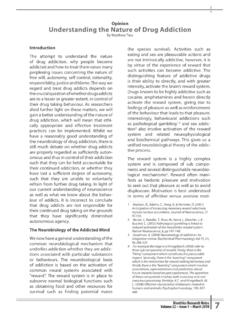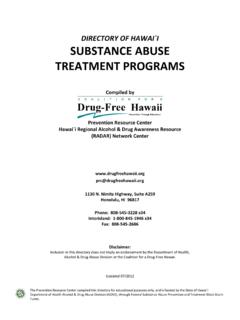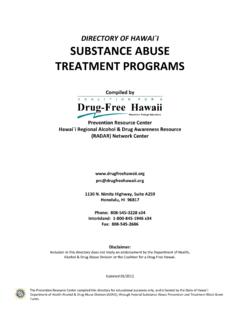Transcription of Meeting Packet for Facilitators - Dual Diagnosis …
1 Meeting Packet for Facilitators (includes group outlines) FOREWORD P O B o x 2 8 8 3 P o r t l a n d , O R 9 7 2 0 8 w w w . d d a o f o r e g o n . c o m ( 8 7 7 ) 2 2 2-1 3 3 2 1 Bob Nikkel, MSW Dual Diagnosis anonymous (DDA) is an inspired and inspiring 12 Step resource key to the recovery of thousands upon thousands of people, present and future, who have experienced two of the most stigmatized disorders in the United States and many other countries--addiction to alcohol and other drugs and, at the same time, mental illnesses ranging from schizophrenia to post traumatic stress disorders, anxieties, and bipolar and unipolar depression.
2 Both addictions and mental health practitioners have been challenged to offer hope for recovery to the often bewildering and complex experiences that result from these so-called "co-occurring disorders." National attention in the United States has been focused on finding more effective approaches to supporting individuals who are both addicted and afflicted at least back to the mid-1980s when the federal government sponsored 12 Young Adult Dual Diagnosis Demonstration projects around the country.
3 These projects did not find all of the answers to how best to approach, treat and sustain abstinence and recovery--the author can state this with some authority and reserve having led one of the more successful projects in Oregon from 1987 to 1990. Many other research initiatives for program improvements have been implemented since then, led and enlightened by many centers, especially the Dartmouth Psychiatric Research Center directed by Dr. Robert E. Drake. The roles that Dartmouth and Dr. Drake will play in the future include researching as well as publicizing the way in which DDA and other self-help approaches can reach across the country, carrying the message of hope and recovery to thousands more people battling co-occurring disorders.
4 Our intent in working with Dartmouth Psychiatric Research Center is to eventually add DDA to the small but growing list of Evidence-Based Practices. 2 One of the crucial and most elusive ingredients for recovery has been that of consistent and attractive mutual self-help support groups. Other approaches such as Dual Recovery and Double Trouble groups are similar in some ways to DDA's approach. However, DDA is clearly founded upon the 12 step traditions as foundational to the approach. The work of Corbett Monica, starting in the 1990s in Southern California with the inception of the first recovery groups, was directly modeled on the traditions of Alcoholics anonymous and Narcotics anonymous .
5 This approach has found sustained success in Oregon over the past four years. Starting from no groups at all in 2005, DDA of Oregon has grown to include several thousand participants in well over 100 local chapters in the beginning of 2010. Dual Diagnosis anonymous has expanded to at least 12 other states including New York, Connecticut, New Jersey. The leadership represented by Mr. Monica has been instrumental in creating this incredible groundswell of recovery for people many professionals had abandoned or simply thrown up hands in despair over nudging toward recovery using traditional methods.
6 As noted, the most important work accomplished by Mr. Monica and his fellows and sisters in recovery has been a clear dedication to the 12 Steps of AA and NA, the 12 Traditions, but with the flexible adaptation of 5 additional Steps specific to DDA. With these steps, DDA recognizes the unique challenges for people with co-occurring disorders and adds crucial elements of social support so often lacking for people with mental illnesses and is a key to preventing relapse. The DDA website at and the network of recovering people linked to this organization will continue to provide information and assistance as DDA expands nationally.
7 The manual you now have available in this publication is a tribute to the power of these steps and traditions but also testament to the need for Twelve Step Facilitation by persons who may not be in recovery themselves from these dual disorders--but who can play an indispensable role in assuring the 3 continued development and sustainability of DDA. One simple fact that drives home the point of the need for many more Facilitators of DDA has come to the author's attention recently. When asked how many miles Mr.
8 Monica has recorded on his subcompact car in the past two years, the answer came--80,000 miles! This speaks volumes to both the dedication exhibited every time one speaks with Mr. Monica, but also to the obvious demand for more skilled group Facilitators --both in recovery as well as understanding of recovery-oriented 12 step approaches. As if this explanation of the history and approach of DDA is insufficient to persuade the skeptical of the influence of 12 step approaches, even a nationally recognized defense intellectual like Thomas Barnett in his latest book, Future Power, uses the 12 steps as inspiration for fundamental recovery of this nation's foreign and military policy approaches.
9 When one fully appreciates the profound influence of the bedrock principles of AA, NA, and now DDA, there should be more than enough motivation for professionals, whether in recovery or not, to take up the practical lessons and guidelines supplied in this manual--and to apply them to the establishment and maintenance of Dual Diagnosis anonymous meetings. Our hope is that as more adolescents, young adults and adults are exposed to the 12 step traditions through DDA, there will be many more thousands of people contemplating and achieving recovery from both addiction and mental health disorders--and to become involved in both attending and leading DDA meetings.
10 4 TABLE OF CONTENTS I. Introduction 5 II. Facilitated dual Diagnosis anonymous groups as an 7 evidenced based practice III. Guidelines for Facilitators 8 IV. Open/Check-in meetings Introduction 10 V. Topical meetings introduction 13 i. The Rules of Respect, Preamble and 16 Opening Thought Group Outline ii. The Just for Today Group Outline 18 iii. The 12 Steps Plus Five Group Outline 21 VI. Meeting Format and Readings for Facilitators 26 5 DUAL Diagnosis anonymous OF OREGON, INC.






